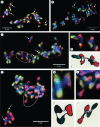Cytogenetic evidence of mixed disomic and polysomic inheritance in an allotetraploid (AABB) Musa genotype
- PMID: 23087127
- PMCID: PMC3503499
- DOI: 10.1093/aob/mcs220
Cytogenetic evidence of mixed disomic and polysomic inheritance in an allotetraploid (AABB) Musa genotype
Abstract
Background and aims: Edible bananas originated mainly from two wild species, Musa acuminata Colla (AA) and Musa balbisiana Colla (BB), and triploid cultivars with an AAA, AAB or ABB genome are the most widely used. In the present study, chromosome pairing affinities are investigated in a sterile AB Indian variety and in its fertile colchicine-induced allotetraploid (AABB) derivative to determine the inheritance pattern of the tetraploid genotype. The potential implications of interspecific recombination and chromosomal composition of diploid gametes for Musa improvement are presented.
Methods: The pairing of different chromosome sets at diploid and tetraploid levels was investigated through a combination of conventional cytogenetic and genomic in-situ hybridization (GISH) analyses of meiotic chromosomes, leading to a likelihood model of the pairing behaviour. GISH analysis of mitotic chromosomes was also conducted to reveal the chromosome constitution of hybrids derived from crosses involving the allotetraploid genotype.
Key results: Analysis of chromosome associations at both ploidy levels suggested that the newly formed allotetraploid behaves as a 'segmental allotetraploid' with three chromosome sets in a tetrasomic pattern, three sets in a likely disomic pattern and the five remaining sets in an intermediate pattern. Balanced and unbalanced diploid gametes were detected in progenies, with the chromosome constitution appearing to be more homogenous in pollen than in ovules.
Conclusions: Colchicine-induced allotetraploids in Musa provide access to the genetic background of natural AB varieties. The segmental inheritance pattern exhibited by the AABB allotetraploid genotype implies chromosome exchanges between M. acuminata and M. balbisiana species and opens new horizons for reciprocal transfer of valuable alleles.
Figures








Similar articles
-
Chromosome Painting in Cultivated Bananas and Their Wild Relatives (Musa spp.) Reveals Differences in Chromosome Structure.Int J Mol Sci. 2020 Oct 24;21(21):7915. doi: 10.3390/ijms21217915. Int J Mol Sci. 2020. PMID: 33114462 Free PMC article.
-
Homoeologous chromosome pairing between the A and B genomes of Musa spp. revealed by genomic in situ hybridization.Ann Bot. 2011 Oct;108(5):975-81. doi: 10.1093/aob/mcr207. Epub 2011 Aug 10. Ann Bot. 2011. PMID: 21835815 Free PMC article.
-
Experimental evidence for the ancestry of allotetraploid Trifolium repens and creation of synthetic forms with value for plant breeding.BMC Plant Biol. 2012 Apr 24;12:55. doi: 10.1186/1471-2229-12-55. BMC Plant Biol. 2012. PMID: 22530692 Free PMC article.
-
Unraveling the genome structure of polyploids using FISH and GISH; examples of sugarcane and banana.Cytogenet Genome Res. 2005;109(1-3):27-33. doi: 10.1159/000082378. Cytogenet Genome Res. 2005. PMID: 15753555 Review.
-
The cytogenetics of homologous chromosome pairing in meiosis in plants.Cytogenet Genome Res. 2008;120(3-4):313-9. doi: 10.1159/000121080. Epub 2008 May 23. Cytogenet Genome Res. 2008. PMID: 18504360 Review.
Cited by
-
How endogenous plant pararetroviruses shed light on Musa evolution.Ann Bot. 2016 Apr;117(4):625-41. doi: 10.1093/aob/mcw011. Epub 2016 Mar 12. Ann Bot. 2016. PMID: 26971286 Free PMC article.
-
A Novel Banana Mutant "RF 1" (Musa spp. ABB, Pisang Awak Subgroup) for Improved Agronomic Traits and Enhanced Cold Tolerance and Disease Resistance.Front Plant Sci. 2021 Sep 23;12:730718. doi: 10.3389/fpls.2021.730718. eCollection 2021. Front Plant Sci. 2021. PMID: 34630479 Free PMC article.
-
Evidence of Genomic Exchanges between Homeologous Chromosomes in a Cross of Peanut with Newly Synthetized Allotetraploid Hybrids.Front Plant Sci. 2016 Nov 1;7:1635. doi: 10.3389/fpls.2016.01635. eCollection 2016. Front Plant Sci. 2016. PMID: 27847512 Free PMC article.
-
Meiotic Behaviors of Allotetraploid Citrus Drive the Interspecific Recombination Landscape, the Genetic Structures, and Traits Inheritance in Tetrazyg Progenies Aiming to Select New Rootstocks.Plants (Basel). 2023 Apr 12;12(8):1630. doi: 10.3390/plants12081630. Plants (Basel). 2023. PMID: 37111854 Free PMC article.
-
Recombination and Large Structural Variations Shape Interspecific Edible Bananas Genomes.Mol Biol Evol. 2019 Jan 1;36(1):97-111. doi: 10.1093/molbev/msy199. Mol Biol Evol. 2019. PMID: 30403808 Free PMC article.
References
-
- Agarwal PK. Cytogenetical investigations in Musaceae I. Meiotic studies in South Indian bananas. Cytologia. 1983;48:847–852.
-
- Agarwal PK. Cytogenetical investigations in Musaceae III. Meiotic studies in diploid Musa species and banana varieties of India. Cytologia. 1988;53:359–363.
-
- Bakry F, Paulo De La Reberdiere N, Pichot S, Jenny C. In liquid medium colchicine treatment induces non chimerical doubled-diploids in a wide range of mono- and interspecific diploid banana clones. Fruits. 2007;62:3–12.
-
- Bakry F, Carreel F, Jenny C, Horry J-P. Genetic improvement of banana. In: Jain SM, Priyadarshan PM, editors. Breeding plantation tree crops: tropical species. New York: Springer; 2009. pp. 3–51.

